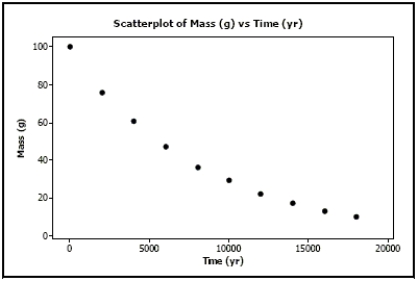Carbon dating QuarkNet, a project funded by the National Science Foundation and the U.S. Department of Energy, poses the following problem on its website:"Last year, deep within the Soudan mine, QuarkNet teachers began a long-term experiment to measure the amount of carbon-14 remaining in an initial 100-gram sample at 2000-year intervals. The experiment will be complete in the year 32001. Fortunately, a method for sending information backwards in time will be discovered in the year 29998, so, although the experiment is far from over, the results are in."
A scatterplot of the data looks like: 
a. Straighten the scatterplot by re-expressing these data and create an appropriate model for predicting the mass from the year.
b. Use your model to estimate what the mass will be after 7500 years.
c. Can you use your model to predict when 50 g of the sample will be left? Explain.
Correct Answer:
Verified
View Answer
Unlock this answer now
Get Access to more Verified Answers free of charge
Q131: The correlation coefficient between high school grade
Q132: Penicillin Doctors studying how the human
Q133: Associations For each pair of variables, indicate
Q134: Which statement about residuals plots is true?
I.
Q135: Email At CPU every student gets a
Q137: Which is true?
I. Random scatter in the
Q138: Education research consistently shows that students from
Q139: A study examined the number of
Q140: For families who live in apartments the
Q141: A residuals plot is useful because
I. it
Unlock this Answer For Free Now!
View this answer and more for free by performing one of the following actions

Scan the QR code to install the App and get 2 free unlocks

Unlock quizzes for free by uploading documents